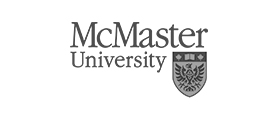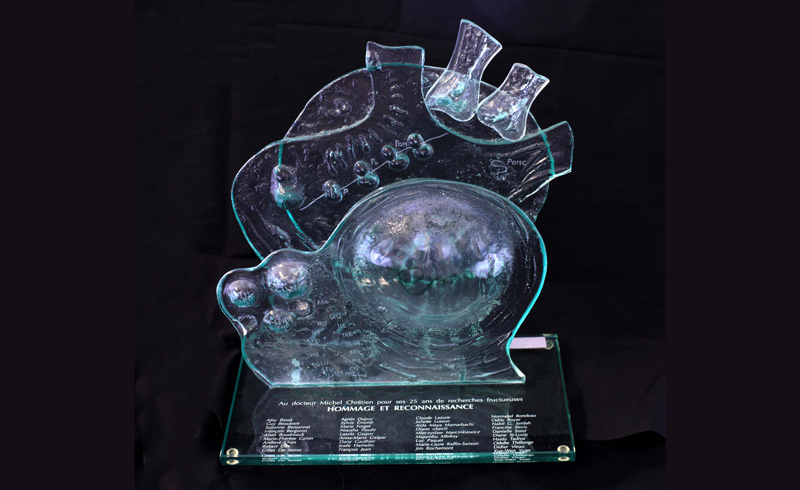
-
Careers • News • Contact us •
- Login
- Français
Creating new
knowledge
Exploring new avenues to develop tomorrow’s medical knowledge through an approach that integrates basic and clinical research
Our research units are led by principal investigators who collaborate in a spirit of collegiality and with the vision of bridging the gap between research and patients. They train the next generation of scientists and are independent and creative minds who work tirelessly to improve health.
Current research
"Our objective is to research the mechanisms of homeostasis regulation by peptide hormones and their synthetic enzymes in human and experimental physiology and pathology."
Michel Chrétien, Emeritus Research Professor
Functional Endoproteolysis Laboratory
After receiving an M.D. (U. de Montréal, 1960) and an M.Sc. in Experimental Medicine (McGill U., 1962), Michel Chrétien specialized in clinical research with Jacques Genest (U. De Montréal, 1960–62), in endocrinology with G. Cahill/G. Thorn (Harvard U., 1962–64); in protein chemistry with C. H. Li (UC Berkeley, 1964–67), and in neuroscience with R. Guillemin/L. Iversen (Salk Institute/Cambridge U., 1979–80). While at Berkeley and sequencing β-lipotropin (LPH), he discovered γ-LPH and proposed, simultaneously with Donald Steiner, the PROHORMONE THEORY. According to this theory, the biosynthesis of peptide hormones requires endoproteolytic cleavage at basic amino acid pairs of inactive proproteins. The concept of proprotein convertases (PCs) was born, which were only identified 23 years later.
In 1976, M. Chrétien discovered human β-endorphin which is the C-terminal fragment of β-LPH and is part of a precursor also containing ACTH, a proprotein he named Pro-Opio-Melano-Cortin (POMC). With P. Crine, N. Seidah, G. Boileau, S. Benjannet and C. Gianoulakis, he described the entire POMC endoproteolytic pathway to β-endorphin, MSHs and ACTH. Later, prohormone theory was extended to neurotrophin biosynthesis, growth and transcription factors, receptors, extracellular matrix proteins, bacterial toxins, viral glycoproteins, etc. The endoproteolytic cascade of PCs has been shown to be a fundamental cellular process affecting basic biological functions from embryo to adulthood and into aging.
In the 1990s and early 2000s, the laboratories of Chrétien/Seidah and their collaborators M. Mbikay, S. Benjannet, C. Lazure, M. Marcinkiewicz, R. Day, A. Basak and others, discovered seven of the nine proprotein convertases (PC/PCSK). In humans, genetic polymorphisms specific to PCs and POMC cause disease. For example, POMC and PC1 mutations are implicated in obesity, diabetes. PCSK9 gain of function (GOF) causes familial hypercholesterolemia (FH). In contrast, PCSK9 LOF variants are cardioprotective by lowering plasma LDL-C. From a troublesome gene, PCSK9 has become a good therapeutic target to treat hypercholesterolemia. In 2011, Chrétien discovered the LOF PCSK9Q152H mutation in French-Canadian families, which is the most cholesterol-lowering in Caucasians. He assembled a unique cohort of 33 mutant subjects (including 3 homozygotes) and performed further clinical, biochemical, and medical imaging evaluations.
The results revealed that the mutants, 50% between the ages of 50 and 91, were in excellent health, including their cardiovascular condition and liver function. These observations, combined with experimental studies of PCSK9Q152H by Richard Austin of McMaster U., led them to publish, in a recent Journal of Clinical Investigation article, that the PCSK9Q152H mutation protects against both cardiovascular and liver disease. Mutants live longer lives in good health. PCSK9Q152H is becoming a target of choice for gene therapy.
The current collaborations of Dr. M. Chrétien and Dr. M. Mbikay (IRCM) with Dr. S. Turcotte (CHUM) are evaluating PCSK9 as a regulator of the MHC class 1 cellular pathway in human colorectal cancer cells and its potential role in cancer immunotherapy.
Following a clever hunch by M. Mbikay (IRCM) about the activity of isoquercetin on the PCSK9/cholesterol cascade, the Chrétien/Mbikay duo, in collaboration with the NML in Winnipeg, discovered that isoquercetin is a potent anti-Ebola drug in vivo and that it inhibits SARS-CoV2 replication. During the Ebola (2018) and COVID-19 (2020–21) epidemics, M. Chretien, M. Mbikay and J. Carver (ICAV) made substantial efforts to test isoquercetin as a first-line antiviral. Their concept is based on the following findings:
- that epidemics caused by new viruses are more frequent and more deadly;
- that health care is not prepared to respond at the first appearance of outbreaks;
- that no drugs are available to slow the first waves before vaccines become available;
- that testing isoquercetin, a broad-spectrum antiviral approved by Health Canada and the FDA, fully available, inexpensive, and easy to administer, could compensate for the lack of specific antivirals.
In 61 years of clinical and basic research, Michel Chrétien’s career fits well with the expression “from the bedside to the bench and back to the bedside.” He has authored and co-authored over 600 scientific publications and has trained nearly 100 fellow researchers, many of whom have become leaders in academia.
| Team |
|
| Affiliations |
LEADERSHIP POSITIONS
RESEARCH POSITIONS
ACADEMIC POSITIONS
|
| Degrees and experience |
DEGREES AND CERTIFICATIONS
POSTDOCTORAL TRAINING
|
| Publications |
Ongoing Projects
Proposal for a clinical trial of isoquercetin as an antiviral agent against Ebola and COVID-19
PCSK9 released into the blood by the liver increases blood cholesterol levels. During our work on the regulation of this protein, we found that isoquercetin, a small molecule of plant origin known for its antioxidant and anti-inflammatory properties, could decrease the production of PCSK9 by the liver and its release into the blood. Based on the hypothesis that high blood cholesterol levels, caused by increased PCSK9 activity (among other things) could promote the proliferation of infectious agents, we set out to investigate the anti-infective effects of isoquercetin. In collaboration with the National Microbiology Laboratory (NML) in Winnipeg, we have demonstrated that this molecule can remarkably prevent and mitigate Ebola virus disease in mice.
With the outbreak of the COVID-19 pandemic, our collaboration with NML quickly turned to this new disease caused by the SARS-CoV2 coronavirus. We showed that in vitro isoquercetin could stop the infection of cells by this virus. Trials on the efficacy of the molecule in mice susceptible to COVID-19 are underway. Furthermore, to explain this anti-SARS-CoV2 effect, we are investigating whether isoquercetin could disrupt certain facilitating links between the proteins of the virus and those of the human cell.
In collaboration with J. Carver (ICAV: International Consortium of Anti-Virals), we propose to conduct a phase II clinical trial with the main objective of evaluating the effect of isoquercetin (IQC) on disease progression (length of hospital stay and mortality) and viral load reduction when administered orally. They hope that stopping the infection early will prevent the long COVID-19 syndrome that affects between 10-20% of patients.
PCSK9, isoquercetin, and liver cancer
PCSK9 is produced by the liver, but its overproduction seems to promote liver diseases, such as fatty liver, hepatitis, cirrhosis, and cancer. We have discovered in four French-Canadian families the Q152H variant of PCSK9, which prevents the cleavage required for the release of this protein into the blood. In addition to lowering blood cholesterol levels, this variant trapped in liver cells reduces stress in that organ, thus protecting carriers against both heart disease and liver disease.
We also found that any uncleaved form of PCSK9, when released into the bloodstream as a result of any cellular abnormality, is recognized by the immune system, which produces antibodies against it. We are investigating whether these autoantibodies could serve as diagnostic and prognostic markers of liver pathologies, including cancer.
On the other hand, since isoquercetin, a phytocompound, in addition to being an antiviral agent, is also a potential anticancer agent, it is possible that this activity is mediated by its inhibitory effects on PCSK9. By studying its anticancer efficacy in PCSK9-producing and non-PCSK9-producing cells or mice, we will determine whether this molecule, alone or in combination with other agents (such as anti-PCSK9 monoclonal antibodies), could improve liver cancer therapy.
Important Discoveries
|
1967 Isolation, purification and characterization of g-lipotropic hormone from sheep pituitary glands |
|
1976 Isolation of peptides with opiate activity from sheep and human pituitaries: relationship to b lipotropin |
|
1977 In vitro biosynthesis of β-endorphin in pituitary glands |
|
1980 A novel human pituitary peptide containing the g-MSH sequence |
|
1982 Isolation and NH2-terminal sequence of a novel porcine anterior pituitary polypeptide: homology to proinsulin, secretin and Rous sarcoma virus transforming protein TVFV60 |
|
1990 cDNA sequence of two distinct pituitary proteins homologous to Kex2 and furin gene products: Tissue-specific mRNAs encoding candidates for pro-hormone processing proteinases |
|
1995 Proprotein convertases and the pathophysiology of human diseases: prospective considerations. Proc. Assoc. Am. Physicians 107:47-66, 1995 |
|
2011 Novel Loss-of-Function PCSK9 Variant Is Associated with Low Plasma LDL Cholesterol in a French-Canadian Family and with Impaired Processing and Secretion in Cell Culture |
|
2021 The loss-of-function PCSK9Q152H variant increases ER chaperones GRP78 and GRP94 and protects against liver injury |
Tools
| Press review |
|
| Grants |
|
| Recognitions and honors |
Cellular model of POMC, the precursor of beta-endorphin, ACTH and MSHs. Sculpture designed by Mrs. Suzanne Benjannet and realized by Mrs. Diane Mineau. |
Join the
group Research
Available positions
Ongoing clinical studies
Research Partners






Join the
research group
514 987-5664
michel.chretien@ircm.qc.ca
Life in the
laboratory

© Montreal Clinical Research Institute, Année.All rights reserves. | Privacy policy | Terms of use | Web site by Agence Riposte




